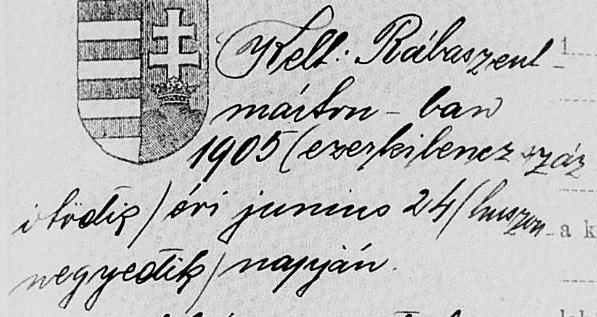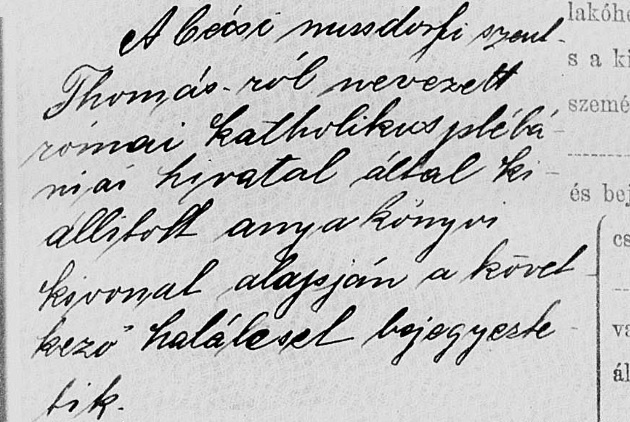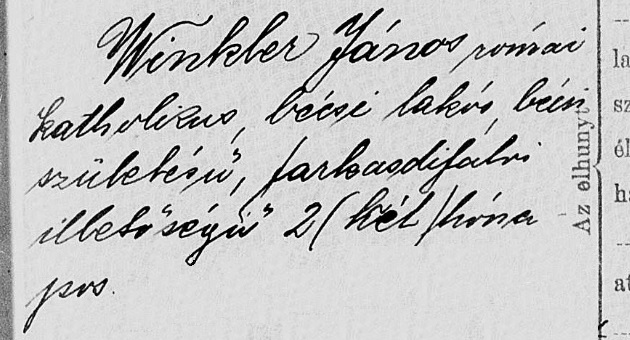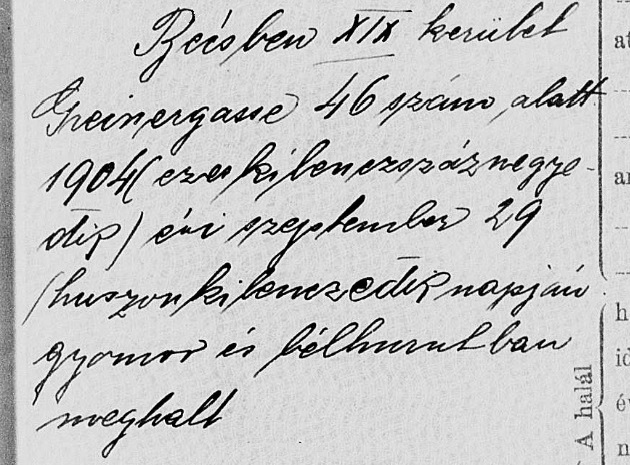|
The
|
|||||||||||||||||||||||||||||||||||||||||||||||||
THE BURGENLAND BUNCH NEWS - No. 301 September 30, 2019, © 2019 by The Burgenland Bunch All rights reserved. Permission to copy excerpts granted if credit is provided. Editor: Thomas Steichen (email: tj.steichen@comcast.net) BB Home Page: the-burgenland-bunch.org BB Newsletter Archives: BB Newsletter BB Facebook Page: TheBurgenlandBunchOFFICIAL Our 23rd year. The Burgenland Bunch Newsletter is issued monthly online. The BB was founded in 1997 by Gerald Berghold, who died in August 2008. |
|||||||||||||||||||||||||||||||||||||||||||||||||
| Current Status Of The BB: * Members: 2894 * Surname Entries: 8796 * Query Board Entries: 5777 * Staff Members: 13 |
|||||||||||||||||||||||||||||||||||||||||||||||||
|
|||||||||||||||||||||||||||||||||||||||||||||||||
1) THE PRESIDENT'S CORNER (by Tom Steichen)  This
month's collection of bits and pieces in Article 1, starts off with a very minor update
concerning the long-awaited announcement of the release by the Eisenstadt diocese of the online Burgenland Catholic
records. We follow that with the announcement of the completion of the transcription of the Steingraben church
and civil records spanning 1828 to 1920. This
month's collection of bits and pieces in Article 1, starts off with a very minor update
concerning the long-awaited announcement of the release by the Eisenstadt diocese of the online Burgenland Catholic
records. We follow that with the announcement of the completion of the transcription of the Steingraben church
and civil records spanning 1828 to 1920. Article 2 is the second of two parts of a somewhat-long 1994 journal article that reported on a study done shortly after the fall of the Iron Curtain (in 1989). As I mentioned when introducing the first part, I intended to add comments... but then I decided I'd rather have you hear the original voices, without my words influencing your interpretation of what is said. The study examines the "Divergent Development" of Moschendorf, Austria, and Pinkamindszent, Hungary, Two Villages on Opposite Sides of the 1921 Austro-Hungarian Border ...yet within sight of each other. Part 1 of the article described research methods, provided pre-1921 background, then described differences that developed after the 1921 establishment of Burgenland and the new national border. Part 2 of the article speaks to "the decisive rupture," which came only after the end of WW-II with the establishment of the Iron Curtain and with the associated changes in the political environments. Despite being specifically about the two named villages, I'm sure the key points made by the authors in the article apply in various ways to all villages along this border, so the article should be of interest to all of us... read and ponder what it teaches. Article 3 is a Trip Report, one by Anita O'Brien, telling of her trip to Maria Weinberg with her daughter in July of this year. It seems clear that it was an enjoyable and sentimental trip, as it was the first time her daughter visited the home region of Anita's emigrant mother. Article 4 is the second of three related articles, wherein I try to make accessible the "Marginal" Entries found in Civil Records, in this case in the Death records. Marginal entries are those hand-written in the margins of the pre-printed "long" Hungarian birth, marriage and death records, with the form X'd out and its fields left blank. Two months ago, I worked through a marginal marriage record; in a subsequent newsletter, I'll decipher a marginal entry in the birth records. The remaining articles are our standard sections: Historical Newsletter Articles (this month providing the origins of two BB features), and the Ethnic Events and Emigrant Obituaries sections.  Online
Burgenland Catholic Church Books: As noted previously, the Catholic Diocese of Eisenstadt, which covers all of
Burgenland, announced in July that digital images of its baptism, marriage and deaths book pages will be available online
this Fall. Online
Burgenland Catholic Church Books: As noted previously, the Catholic Diocese of Eisenstadt, which covers all of
Burgenland, announced in July that digital images of its baptism, marriage and deaths book pages will be available online
this Fall. The latest word is that a website will open in October that will contain the details about the data and access to it. However, only a very nebulous statement was made concerning the actual availability of the data, so nebulous that I could not interpret whether image access will begin before or after the end of the year! Thus we will need to wait for the opening of the website for more information. I'll write again then...  Vital
Records Transcription: As said a few months back, we continue to add transcriptions... this month, we complete the
Steingraben transcribed-records collection, adding the 200 civil deaths. Vital
Records Transcription: As said a few months back, we continue to add transcriptions... this month, we complete the
Steingraben transcribed-records collection, adding the 200 civil deaths. It should be noted that Steingraben (Hungarian: Bányácska / Bánya; Croatian: Bojane) was just one village in the Catholic parish of Gerersdorf (Hungarian: Németszentgrót); other villages in the parish were Gerersdorf itself, Rehgraben (Hungarian: Özgödör, Croatian: Prašcevo) and Sulz (Hungarian: Sóskut; Croatian: Šeškut). Later, it was, similarly, just one village in the Gerersdorf civil recording district, which also included the above-named villages as well as, for years 1907 and 1908, Heugraben, Kroatisch Tschantschendorf, Krottendorf, Neustift bei Güssing and Tudersdorf. Regardless, this Steingraben transcribed-records collection (1895-1920) contains only records that involve Steingraben. This arose because the collection began as a private effort by BB member Charles von Breitenbach, whose ancestors had a long history in Steingraben. He began by transcribing Catholic birth records for family members there, including another village of the parish only if the record also involved a parent from Steingraben. With some help from me, the project was expanded to include all Steingraben-related births, whether or not they included a known relative of Charles. Later, I induced Charles into helping transcribe all Catholic death records for Steingraben and I chose to transcribe the corresponding Catholic marriages. Having done that, it only seemed reasonable to transcribe the civil records for Steingraben, and all are now available. The Steingraben transcriptions are implemented in sortable table format, found (directly) here: ChurchRecords/Steingraben/SteingrabenRecords.htm. Alternatively, you can start on the BB homepage and scroll down to the “Vital Records Transcriptions” section, then follow the appropriate links. 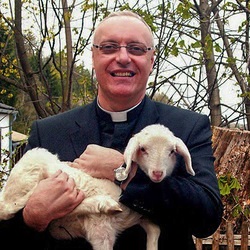 Visit
From The Eisenstadt Diocese Bishop Has Been Cancelled: Visit
From The Eisenstadt Diocese Bishop Has Been Cancelled:We have been informed that the Bishop has had to cancel his upcoming visit to Canada and the US since he must, unexpectedly, attend an extremely important conference in Brussels. The Bishop apologizes for the short notice and any inconvenience this causes and hopes to be able to make the trip sometime in the future. Unfortunately, I have no details about any public events yet (but will add them to this newsletter as they become available). Late word suggests that the Bishop will be in the Lehigh Valley on Friday, October 25, though details of that visit are still being worked out... more here when I know more! 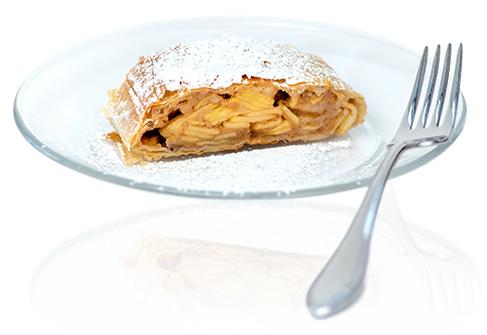 Looking
for Authentic Austrian Strudel? It was pointed out to me that there is an authentic Austrian bakery in Sterling, VA
(in the greater Washington DC metro area) that sells many varieties of strudel. Products can be purchased via their website
little-austria.com or at a number of farmer's markets in the DC area. Looking
for Authentic Austrian Strudel? It was pointed out to me that there is an authentic Austrian bakery in Sterling, VA
(in the greater Washington DC metro area) that sells many varieties of strudel. Products can be purchased via their website
little-austria.com or at a number of farmer's markets in the DC area.As a little background, the business began as a small, private operation... an Austrian-born woman making strudel for friends... then word got out. Now it is a formal business run by the lady; and her husband vends her products in weekend farmer’s markets around DC. As always, mention in the BB newsletter is not an endorsement; rather it is information that might be of interest to you. You are responsible for your decision to purchase, or not, any items. I personally have not tried their products, so cannot speak to their quality or value. 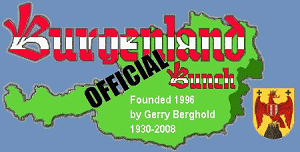 The
Facebook Bunch (from Vanessa Sandhu): The
Facebook Bunch (from Vanessa Sandhu): Greetings Burgenland Bunch! Here’s a quick recap of what we’ve been up to in our Facebook group. If you haven’t joined us yet, please consider doing so. We have a lot of fun and are constantly learning from one another. We currently have 1,070 members, so chances are good that someone will be able to answer any questions you might have. We had 32 new members join us this month. facebook.com/groups/TheBurgenlandBunchOFFICIAL/ I am working on firming up a date for our very first Lehigh Valley/East Coast BB Facebook meet-up! I will be polling all interested parties very soon to see what date will work for everyone. We are aiming towards gathering in early November. We also have quite a few Chicago Burgenland descendants who are interested in getting together as well. I will keep you updated as soon as I hear any news regarding a gathering. As usual, our amazing members have been very active and helpful, assisting with many lookups and translations. We had an unofficial meetup at the Coplay Sängerbund for the annual Oktoberfest, held on September 15. We had excellent weather and a fantastic time. Entertainment was provided by the Josef Kroboth Orchestra and the Auerhahn Schuhplatters. It was so nice to meet BB Facebook members Sylvia DeLuca, Heidi Simon and Kristen Fallon! If you haven’t attended any events at the Sängerbund lately, please consider visiting one. You will have a great time! I hope to see you there! 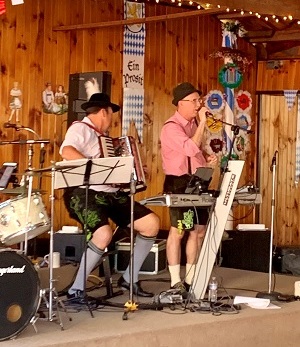
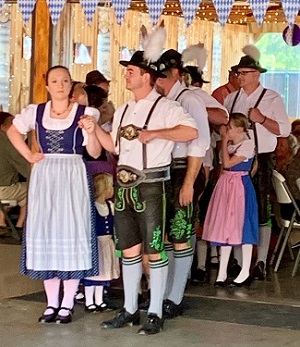
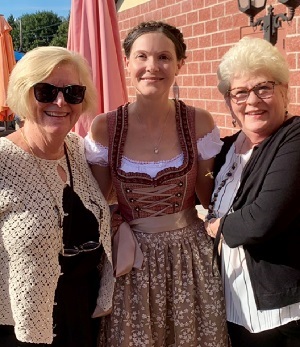 This month’s musical selection comes to us from Musibanda Gramüposcha and is entitled Ein Burgenländer Musikant. Enjoy! youtube.com/watch?v=-EbtdILX0Ts&feature=youtu.be Finally, here is a really beautiful drone flight recorded by Land Burgenland. See Burg Güssing in all of its splendor! facebook.com/304565426313432/posts/1943235822446376 Have a great day! Vanessa  Update
for book "The Burgenländer Emigration to America": Here is this month's update on purchases of the English issue of
the 3rd edition of Dr. Walter Dujmovits' book "Die Amerika-Wanderung Der Burgenländer." Update
for book "The Burgenländer Emigration to America": Here is this month's update on purchases of the English issue of
the 3rd edition of Dr. Walter Dujmovits' book "Die Amerika-Wanderung Der Burgenländer."Current total sales are 1444 copies, as interested people purchased 4 more books during this past month. As always, the book remains available for online purchase at a list price of $7.41 (which is the production charge for the book, as we purposely choose not to make a profit so we can avoid dealing with the income tax consequences and so you can obtain the book at as low a cost as possible!), plus tax & shipping. See the BB homepage for a link to the information / ordering page and for information about current discounts (there is at least one discount on price or shipping available most of the time... if not, wait a few days and there will be one!). Burgenland Recipes: This recipe is from ongoing contributor Christine Rubba.  Lentils
with Bratwurst (Linsen mit Bratwurst) Lentils
with Bratwurst (Linsen mit Bratwurst)Ingredients: 1 lb lentils 1/2 onion shortening salt sharp paprika 1 bratwurst per person sour cream Preparation-previous evening: Soak the lentils overnight in water to soften and plump them. Preparation-next day: Chop the onions, add them to a deep casserole and brown them in shortening. Add salt and paprika to taste. Add the lentils and briefly brown them. Pour in some water (or better, broth) and steam until they are soft, almost pulpy. Split the bratwurst in half lengthwise, then peel and slice into 3/4-inch pieces. Brown well. Spread the lentils onto a flat serving platter and lay the bratwurst on top. Serve with sour cream, which makes the lentils creamy, and accompany with bread and green salad.  Note:
We have updated the recipes sortable list with links directly to the recipes or food-related
articles published in our past newsletters. You can access the list by clicking our recipe box (to the right). Thanks to the
contributions of our members over the years, we have quite a collection of Burgenland recipes, some with several variations. Note:
We have updated the recipes sortable list with links directly to the recipes or food-related
articles published in our past newsletters. You can access the list by clicking our recipe box (to the right). Thanks to the
contributions of our members over the years, we have quite a collection of Burgenland recipes, some with several variations.However, we have or will soon use up the few remaining unpublished recipes we have... and when those are gone, this recipe section will become dormant. Nonetheless, we are always on the lookout for fresh ideas, so, if you have a favorite family recipe, please consider sharing it with us. We will be happy to publish it. Our older relatives, sadly, aren't with us forever, so don't allow your favorite ethnic dish to be lost to future generations. You can send your recipe to BB Recipes Editor, Alan Varga. Thanks! Cartoon of the Month: 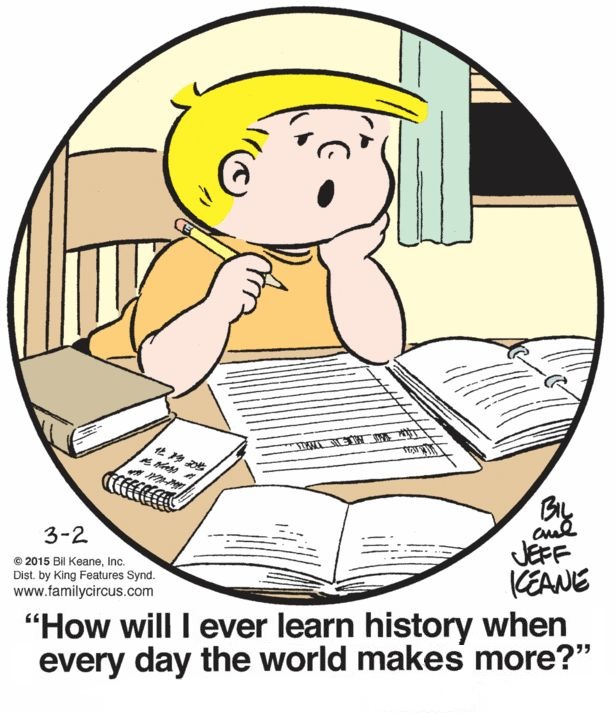 |
|||||||||||||||||||||||||||||||||||||||||||||||||
2) THE DIVERGENT DEVELOPMENT OF TWO VILLAGES IN THE AUSTRO-HUNGARIAN BORDER REGION [Part 2] (by Monika Maria Varadi and Doris Wastl-Walter) Originally published: Estudios Fronterizos. Núm. 34, julio-diciembre de 1994, pp. 167-193 (publicly available on the web here: pdf file) Part 1 of this article was published here: Newsletter 299 #2. We continue with our second and final part: THE PARTING OF THE WAYS (1945-1960) The last days of the War and the first years after were very difficult for this region. For two weeks, the military front line went right through these villages and, after the War, the soldiers and foreign workers who left the region by train from Pinkamindszent did a lot of damage there. As people had no machines, no seeds and no fertilizer, no animals and no workers, the agricultural situation was truly desperate. It took some years to reach crop yields equal to those of the time before the War. Slowly the economic situation improved, also with help from the US: "Yes, my mother sent us parcels. She was also old, she could not do much. But my cousin and others could help us a little—also with money—my cousin, they could." Another possibility for getting money in Moschendorf was still smuggling. In the fifties, things changed. Especially the Southern Burgenland found itself in an completely new geopolitical situation. It had always been a quite underdeveloped region, but it was in the center of the Austro-Hungarian Monarchy, where it had a long history of strong interconnected relationships, and it had lost its historical ties only little by little during the period between the two Wars. Now people found themselves on the outermost edge of Western Europe, in the Russian zone of occupation, in the Eastern periphery of Austria and without any possibility of contacting their former near-neighbors. As a result, the development of the agricultural structure and industrialization took much more time than in other parts of Austria, and emigration, mostly to the United States, was still important. In 1950 both villages had about 630 inhabitants (Pinkamindszent, 1949: 659; Moschendorf, 1951: 623). In the nineties both lost population, but Moschendorf lost only 25%, while Pinkamindszent lost 70%. For Pinkamindszent, the shock was even worse than for Moschendorf. Its status changed from that of a region in the heart of Central Europe to that of a region on the extreme periphery of the East, just in front of the Iron Curtain, which had been established there in 1948. People no longer had the freedom to contact their neighboring village, which they could see from their homes. As a result, 1948/1949 saw the beginning of an emigration which has changed irreversibly the demographic structure of the local society. The process went on continuously; but twice the dimension increased quickly and even dramatically: between 1949 and 1960, and after 1970. The whole process and particular events during these two periods can be seen as a (logical) consequence of the political practice of state socialism. To a larger extent as well, this demographical erosion can be interpreted as one factor in a system which modernizes basically the living conditions of a society. In the life of the population of Pinkamindszent, the consequences of the compulsory socialist modernization are linked with the effects of the location at the border. The people felt the consequences of the "Soviet-Model" for the first time when the border was completely closed. Instead of the permeable and penetrable border of the time from 1921 to 1948, the Iron Curtain was not only a physical, but also a sociologically and psychologically menacing reality. Furthermore, they had not only lost their fields in the area of Moschendorf, but also many fields in Pinkamindszent were taken out of production. The community had a 50m wide and 19km long border area on its western side with Austria where they were allowed to go and cultivate only by special permit, but it was also closed off from the rest of Hungary: the border zone was an isolated area where people were allowed to go by special permission only, and where those who lived there had to prove this with documents. From the point of view of the people concerned, it meant that we became a forgotten community. Another consequence of the isolation was that there were no newcomers, so that these areas did not receive other social groups as did the small villages they had given up in other parts of Hungary (see Kovacs, 1987 and 1990). Notwithstanding the fact that Pinkamindszent was in a forgotten area, the people still had to suffer all the political changes that affected the country as a whole ("Kulak" lists, taxes, collectivization of the bigger businesses). As a consequence of these political measures, there began to be a dissolution of the local society, imperceptible for the moment. "For the moment", because the legal position concerning property was not changed for the time being, and the strong tradition of the rural way of life led to the fact that, until 1959, no farmstead had been given up. But, by 1945 and particularly after 1949-1950, the rural workers, small farmers and artisans had already started to send their children to the socialist industries and to the big towns (mostly Budapest and Szombathely), where they became wage workers. It is typical, and a consequence of the special position of the artisans in the local society, that in the new distribution and organization of power, artisans, or children from artisan families had the new positions. This group of nearly unpropertied artisans, in particular, expected much from the new system. The farmers—following their old strategies—reacted differently to these changes in their social surroundings. The farm families, even under aggravating conditions, continued with business as usual, at the given technical level, and in the traditional working organization of the family. But the younger generation slowly changed their attitude towards agriculture. For them, life as a farmer was no longer the self-evident choice, and surely not the only prospect for life. Also, some parents no longer saw a chance for the future in the home village and sent their sons to higher schools. (The future for the girls was always seen as a good marriage!). The events of 1956 were experienced in Pinkamindszent in a very disciplined and relieved manner. People were very glad to be able to contact old friends. Their greatest surprise was the poverty on the other side of the border: at that time Southern Burgenland was still poor and, for a Western European country, relatively underdeveloped. As to the demographic situation of the local society, it is important to note that between 20 and 30 young people went to the West and emigrated to the United States with the help of their relatives. Table. 3. Decline of Farmsteads in Moschendorf and Pinkamindszent Source: Statistics of agrarian business units.
In spite of the fact that we can already see in all these events and evolutions the processes of later on, we can say
that the local society of both villages in the fifties was characterized by the same traditional agrarian structure and a
general poverty. The basically diverging development only started in the sixties.
The differences in the public investments and the prosperity of the communities have repercussions in the private sector,
particularly in the development of private housing, (See Figures 4 and 5). |
|||||||||||||||||||||||||||||||||||||||||||||||||
3) TRIP REPORT: MARIA WEINBERG, JULY 2019 (by Anita O'Brien) [Editor: We haven't had many "trip reports" in recent years, so I was pleased when Anita agreed to write about her trip to Austria, one which took place at the beginning of July and was her first trip back to Burgenland in over 50 years! It sounds like she had a wonderful time, as she says, "My only regret is that we were in Gaas for only one night and should have stayed two."] 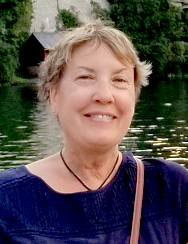 My
daughter and I recently traveled to Austria to see Vienna and Salzburg and, in particular, to make a visit to the town of my
mother’s birth: Gaas (known as Pinkakertes, Hungary, prior to 1921). My
daughter and I recently traveled to Austria to see Vienna and Salzburg and, in particular, to make a visit to the town of my
mother’s birth: Gaas (known as Pinkakertes, Hungary, prior to 1921).
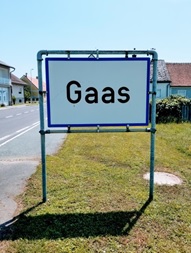 My
mother brought me to Gaas in 1968, when I was 11 years old; and now I’m bringing my daughter so that she can see where her
grandmother and family were born. I wanted her to get a sense of her Austrian heritage so that she can carry this cultural
identity forward to the next generation. My
mother brought me to Gaas in 1968, when I was 11 years old; and now I’m bringing my daughter so that she can see where her
grandmother and family were born. I wanted her to get a sense of her Austrian heritage so that she can carry this cultural
identity forward to the next generation.My mother emigrated through Ellis Island in 1929, along with her mother and brother. They eventually settled in West New York, NJ. Being first generation, I have vivid memories of my mother and grandmother, who brought the culture of Burgenland alive through traditional cooking, speaking native German in our home and, most importantly, their reverence for their church, Maria Weinberg. Growing up, my mother lovingly referred to it as “the miracle church.” According to legend, 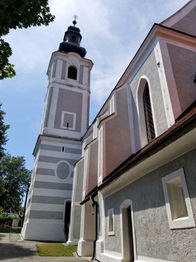 when
the church was being erected, building materials were lying nearby awaiting construction; and the next morning residents
awoke to find that the church had been inexplicably built overnight. when
the church was being erected, building materials were lying nearby awaiting construction; and the next morning residents
awoke to find that the church had been inexplicably built overnight.Upon arriving in Gaas, we checked into our rented Kellerstöckl and immediately set out to visit Maria Weinberg. [Kellerstöckl: An old Austria term for an agricultural building, built into a sloping hillside with a cellar cut far into the slope, used when wine was produced directly in the vineyard. The name derives from the basement, the main part of the building, on which a single-story floor was built to serve as living and sleeping space for workers in the vineyard. The cellar below was usually divided into two parts: The front part used as a working and pressing room, the back as a fermentation and storage cellar. After modernization of viticulture, Kellerstöckl were too small and fell into disrepair. Today, many Kellerstöckl have been converted as tourist apartments, ones where you can wake up to views of a working vineyard.] As we approached the church, we saw it high up on a hill surrounded by vineyards. Dedicated to the Assumption of Mary, the church dates back to the 12th century but has been rebuilt over time. 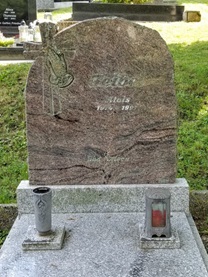 Upon
arrival, we wandered into the cemetery to see if we could find the gravestone of my grandmother’s family. A caretaker and
his friend were there and greeted us in German. The caretaker knew immediately where the Feibel grave was located.
Seeing my grandmother’s family name brought back memories of being in this same spot with my grandmother, mother, and aunt
51 years ago. As we stood in front of the grave, my daughter and I felt the “connection” to this church and realized a sense
of belonging to this place. We said a prayer for our family and then entered the church. Upon
arrival, we wandered into the cemetery to see if we could find the gravestone of my grandmother’s family. A caretaker and
his friend were there and greeted us in German. The caretaker knew immediately where the Feibel grave was located.
Seeing my grandmother’s family name brought back memories of being in this same spot with my grandmother, mother, and aunt
51 years ago. As we stood in front of the grave, my daughter and I felt the “connection” to this church and realized a sense
of belonging to this place. We said a prayer for our family and then entered the church.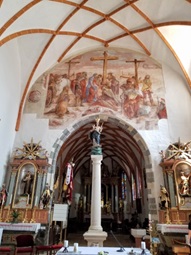 Maria
Weinberg is the largest pilgrimage church in South Burgenland. Built between 1475 and 1524, the altar displays their
treasured gothic Madonna statue. The fresco above the arch, unearthed during a renovation in 1965, is from the 17th century,
and depicts the descent from the cross. The baroque stone column with the statue of the Madonna dates back to 1625. The
church sustained extensive damage toward the end of WW-II, as the front line ran through the lower Pinka Valley. Maria
Weinberg is the largest pilgrimage church in South Burgenland. Built between 1475 and 1524, the altar displays their
treasured gothic Madonna statue. The fresco above the arch, unearthed during a renovation in 1965, is from the 17th century,
and depicts the descent from the cross. The baroque stone column with the statue of the Madonna dates back to 1625. The
church sustained extensive damage toward the end of WW-II, as the front line ran through the lower Pinka Valley.On our drive away from the church and through the vineyards, my daughter and I saw a huge stork flying above us. Its body was long and narrow with the widest wingspan I had ever seen. I remembered my mother telling me that, if a stork built a nest in one’s chimney, it was considered good luck. What an omen for our trip to Gaas! Amazingly, even as we drove away towards the neighboring town of Moschendorf, we could still see the church sitting up above the town overlooking the Pinka Valley—an omniscient beacon reminding us of why we visited. 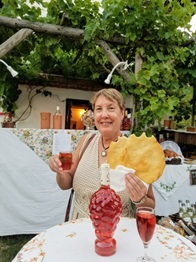 We
drove by Gaas 104 in search of the plot of land where the family homestead once stood. When I visited in 1968, the
house had been torn down, with only a well left standing. Today, a new house stands on the property. We
drove by Gaas 104 in search of the plot of land where the family homestead once stood. When I visited in 1968, the
house had been torn down, with only a well left standing. Today, a new house stands on the property.We then drove over to Heiligenbrunn, where the Uhudler Sommer-Fest was taking place. Uhudler is the local wine in Southern Burgenland. It has a tart flavor and is made from fresh strawberries. Many vendors tempted us with food and drink as we strolled 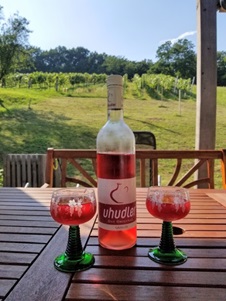 down
the wine-cellar lane that dates back to the 18th century. One treat I particularly enjoyed is the Hungarian langos, a
fried bread made with yeast dough that is rubbed with garlic and sprinkled with salt. It is known as Hungarian pizza
and was introduced by the Turks during their occupation. So gut! down
the wine-cellar lane that dates back to the 18th century. One treat I particularly enjoyed is the Hungarian langos, a
fried bread made with yeast dough that is rubbed with garlic and sprinkled with salt. It is known as Hungarian pizza
and was introduced by the Turks during their occupation. So gut!Surrounded by the local vineyards with Maria Weinberg looking down on us, we enjoyed a bottle of Uhudler on the patio of our Kellerstöckl. We reflected on family and what it meant to be back “home.” I was so happy that I was able to be in Burgenland with my daughter to experience the customs and traditions of my mother’s birthplace. I know that neither of us will ever forget this memorable journey. |
|||||||||||||||||||||||||||||||||||||||||||||||||
4) "MARGINAL" ENTRIES IN CIVIL DEATH RECORDS 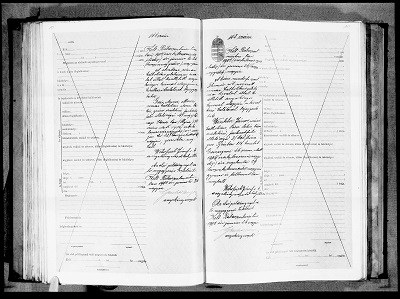 Two
months ago we looked at a "marginal" entry in the Hungarian civil marriage records for the years of the "long form"
entries, 1895-1906. This month we turn to a similar "marginal" entry in the civil death records for that same period. Two
months ago we looked at a "marginal" entry in the Hungarian civil marriage records for the years of the "long form"
entries, 1895-1906. This month we turn to a similar "marginal" entry in the civil death records for that same period.Again, you will see a big X over the pre-printed sections and a lot of handwritten Hungarian text in a marginal area. Like for the marriage records, this indicates a vital event that took place outside of the local recording district but is being added to the local records because the person or family involved has legal standing in a town in the local recording district. [In the US, this type of vital record is called a return or delayed death certificate, and we have similar such returns for births and marriages.] Even though deciphering these marginal entries is difficult, they are the records that may overcome a roadblock for ancestors who apparently "disappeared" from the records, leaving you to wonder what happened to them. The example I show above is a randomly-selected marginal death entry from the Rábaszentmárton (St. Martin an der Raab) civil recording district death records. Marginal death records are harder to decipher than marriages records, mostly because there are more keywords you need to learn and find in the entries, and they are harder to find! But like marriage records, the records have a fairly consistent format (especially within a recording district). However, they are free-form entries, so can and do vary. Nonetheless, we will try to provide the keywords you can key on to find the relevant name, date and places. Below is a blow-up of the actual handwritten entry from above (the digital image is here: familysearch.org/...?i=138&cc=1452460&cat=74426), should you wish to explore further).
So, we see that the name of the deceased leads off the fourth section of the entry (numbered 4a above, as
that section/paragraph typically has two parts, and I've numbered the second part as 4b). We also see that the name is
written in the surname-first Hungarian fashion: Winkler János. The last keyword is illetőségű (belonging to / right of citizenship). In this case, it follows
farkasdifalvai (= in Farkasdifalva), meaning János Winkler belonged to / had citizenship rights in
Farkasdifalva (Neumarkt an der Raab). It is this fact that caused the record extract to be sent to Rábaszentmárton
(St. Martin an der Raab) for recording. |
|||||||||||||||||||||||||||||||||||||||||||||||||
5) HISTORICAL BB NEWSLETTER ARTICLES Editor: This is part of our series designed to recycle interesting articles from the BB Newsletters of 10 years ago. However, again I find myself going back to the early days of the BB, to January 1999, from where I pull extracts from an article Gerry Berghold wrote about Allentown, PA, about the changes already evident in that Burgenländisch emigrant enclave. Gerry wrote it in reply to comments by member Sue Straw. THE BURGENLAND BUNCH NEWS - No. 51A JANUARY 31, 1999 CHANGES TO A MAJOR BURGENLAND IMMIGRANT ENCLAVE: ALLENTOWN, PA Except for the Coke Works, Bethlehem Steel is gone. They're thinking of making a mall out of the plant and leaving all of the structure intact as a museum. Eat a hot dog and see where your immigrant grandfather wrestled with the output of the rolling mills! Not a bad idea. In 1947, on an AHS [Allentown High School) school trip, I was allowed to tap a blast furnace (pushed a button that sounded a warning klaxon and detonated the explosive furnace plug, causing a roar, a shower of sparks and rivers of steel). I've never forgotten the sight! 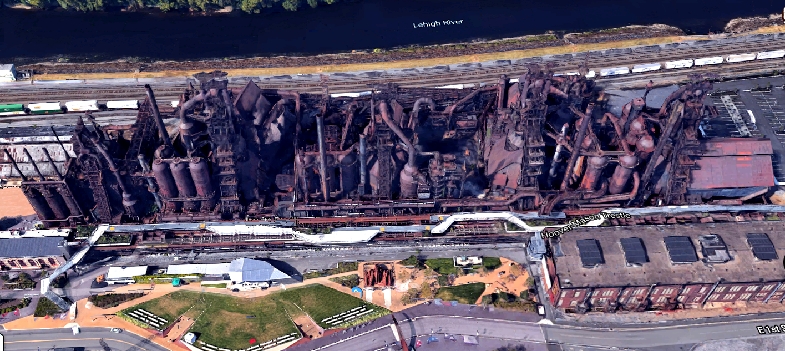 The remnants of Bethlehem Steel: now backdrop for a performance venue called Steel Stacks Allentown-Bethlehem is now becoming a new immigrant enclave, although the small towns to the north (Northampton, Catasauqua, Egypt, Coplay, etc.) are still some what Burgenländisch. People are relocating to the Lehigh Valley from the NYC and northern NJ ethnic regions like they did years ago, mostly Hispanic this time, although there are sprinklings of other ethnic groups including Asian. Not too bad a commute to NY-NJ jobs with the new highways. The Eastern European descendants of immigrants who replaced the Pennsylvania Dutch, who replaced the English, who replaced the Indians (3 or 4 tribes in turn), are in turn being replaced by a new wave of immigrants. Different cultures - different customs, no strudel or paprika, but Hispanics and Asians have their good food specialties too! The Burgenland section of Allentown (6th 10th, 11th wards) is almost gone. Most of the Burgenland clubs and taverns have closed. 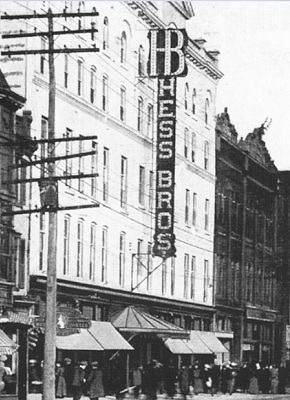 The
city centers are also changing, like so many others, but late coming to this region. Hamilton Street (main-street
Allentown), is now pretty derelict, where once it was the place to see and be seen. I met my wife on the escalator in
Hess's Department Store at Ninth & Hamilton Sts. We both worked there in the early 1950's [Ed: it was demolished in
2000, a year after Gerry wrote this article]. The finest clothing, with many helpful sales people, well groomed
shoppers, the latest in all department store goods, afterwards a choice of fine restaurants, ornate movie palaces, ice cream
parlors or old style snack shops and taverns. A trolley or bus ride home to a quiet tree lined neighborhood. How nice it
was! The
city centers are also changing, like so many others, but late coming to this region. Hamilton Street (main-street
Allentown), is now pretty derelict, where once it was the place to see and be seen. I met my wife on the escalator in
Hess's Department Store at Ninth & Hamilton Sts. We both worked there in the early 1950's [Ed: it was demolished in
2000, a year after Gerry wrote this article]. The finest clothing, with many helpful sales people, well groomed
shoppers, the latest in all department store goods, afterwards a choice of fine restaurants, ornate movie palaces, ice cream
parlors or old style snack shops and taverns. A trolley or bus ride home to a quiet tree lined neighborhood. How nice it
was!Now my old neighborhood (the North end) has many properties boarded up, although someone just fixed up my family's old homestead (sold in 1982 after 78 years of the same family). St. Peters Lutheran, home church of many Burgenländers for 100 years, has moved to the western suburbs and the old church is now a mission church which has become a focal point of the new neighborhood just as it was for the old, Spanish language church service instead of a German one. Don't know if the RC Sacred Heart Church at Fourth & Gordon Sts. has replaced their German mass with a Spanish one [Ed: the current church website indicates bilingual English/Spanish]. When the new immigrants become integrated, it will all come around again. We relocate for a better life style (perhaps we should re-think that) and it can still be found in the Lehigh Valley. Some assimilation already. Lots of changes though. As I remember it, no one seemed to mind steel works pollution; that smell was the smell of money, although, when the wind was just right, the Coke Works could be pretty pungent and the smoke would turn the snow and a clean white shirt black. 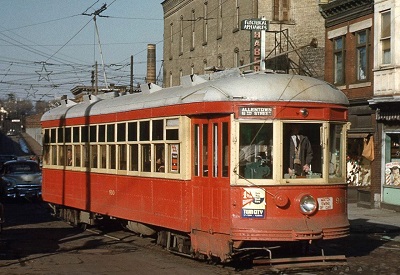 Mostly
restricted to South Bethlehem. Mass transit service was wonderful. A trolley or bus every 7 or 15 minutes, although I had to
run to catch the last midnight trolley from Fountain Hill to Allentown (15 cents) when the wife and I were courting.
Otherwise it cost $1.50 for a taxi. Cabbies often said, "cheaper to get married." Mostly
restricted to South Bethlehem. Mass transit service was wonderful. A trolley or bus every 7 or 15 minutes, although I had to
run to catch the last midnight trolley from Fountain Hill to Allentown (15 cents) when the wife and I were courting.
Otherwise it cost $1.50 for a taxi. Cabbies often said, "cheaper to get married."The reduction in the Steel Works occurred over a period of time following WW-II, so the end didn't appear to be that shattering. Very few of the younger descendants went to work at the Steel. Most found something better. My immigrant Sorger grandfather was a brick-laying foreman in the Open Hearth section, commuting by trolley from Allentown. It eventually killed him (heat stroke); my father worked for the railroad. I went into the Air Force and then college, worked for DuPont in Wilmington. Retired to Winchester. Relocation story of many descendants of older immigrants. Look at the addresses of our members; many have relocated. The first generation immigrant pays the dues, the second lays the groundwork, the third reaps the rewards, the fourth continues upward mobility or takes it all for granted and the fifth, who knows? One of my granddaughters (BA, Columbia 1998) is working for a publishing house in NYC and living in Greenwich Village. From NYC Ellis Island-immigrant back to NYC in five generations, but what a difference in life styles! Some immigrant families have achieved it in less. We had a good life in the Lehigh Valley. Those ethnic neighborhoods were little village enclaves. Shame it had to change, but change is the only permanent thing and the new immigrants need their chance. |
|||||||||||||||||||||||||||||||||||||||||||||||||
6) ETHNIC EVENTS LEHIGH VALLEY, PA Wednesday-Sunday, October 2-6: Oktoberfest at the Reading Liederkranz. Info: www.readingliederkranz.com Friday-Sunday, October 4-6: Oktoberfest at Steel Stacks in Bethlehem (Weekend 1). Info: www.steelstacks.org/festivals/oktoberfest Sunday, October 6: Sunday Dance at the Coplay Sängerbund. Music by The Jolly Bavarians. Info: www.coplaysaengerbund.com Sunday, October 6: Pastorius Association Fall Festival at the Schnecksville Fire Co. in Schnecksville. Music by the Josef Kroboth Orchestra. Info: (610) 767-6981. Friday-Sunday, October 11-13: Oktoberfest at Steel Stacks in Bethlehem (Weekend 2). Info: www.steelstacks.org/festivals/oktoberfest Sunday, October 13: Sunday Dance at the Coplay Sängerbund. Music by Polka Whooo. Info: www.coplaysaengerbund.com Sunday, October 20: Weinlesefest (Grape Dance) at the Coplay Sängerbund. Music by The Emil Schanta Band. Info: www.coplaysaengerbund.com Sunday, October 20: Weinfest at the Lancaster Liederkranz. Info: www.lancasterliederkranz.com Sunday, October 27: Halloween Dance at the Coplay Sängerbund. Music by the Josef Kroboth Orchestra. Info: www.coplaysaengerbund.com NEW BRITAIN, CT Friday, Oct 4, 7 pm: Heimat Abend. Austrian Donau Club, 545 Arch Street, $3. Music by Frank Billowitz. Friday, Oct 18, 7:30 pm: Heurigan Abend. Austrian Donau Club, 545 Arch Street, $3. Music by Schachtelgebirger Musikanten. ST. LOUIS, MO – Consider attending if you are visiting the St. Louis Area! Sunday, Oct 27, Noon - 3pm: Cemetery Crawl. Calvary Cemetery. Car pool will leave from Holy Name of Jesus Church (10235 Ashbrook Dr 63137) upper parking lot at noon OR meet at Calvary Cemetery entrance at 12:15. Dinner afterwards at the Feasting Fox German Restaurant. Please let us know you are coming in advance for ease of locating plots. Info: mcwilliamstheresa1@gmail.com November 2019: Burgenland Ancestral Research Workshop. Two of our local researchers will be sharing tips on how to find information on our Burgenland ancestors. Date will be posted on the BB and STL BB Facebook pages as well as in the October Newsletter. Location contingent on number attending. Reserve a space at mcwilliamstheresa1@gmail.com |
|||||||||||||||||||||||||||||||||||||||||||||||||
7) BURGENLAND EMIGRANT OBITUARIES  None this month, as the number
of surviving emigrants from the most recent wave of emigrants (post-WW-II) is now quite small. It is our expectation that
months with no emigrant obituaries will become more frequent, eventually causing us to drop this section. None this month, as the number
of surviving emigrants from the most recent wave of emigrants (post-WW-II) is now quite small. It is our expectation that
months with no emigrant obituaries will become more frequent, eventually causing us to drop this section. |
|||||||||||||||||||||||||||||||||||||||||||||||||
| END OF NEWSLETTER (Even good things must end!) |
|||||||||||||||||||||||||||||||||||||||||||||||||
|
Burgenland Bunch Newsletter, copyright © 2019 by The Burgenland Bunch |
|||||||||||||||||||||||||||||||||||||||||||||||||
 News
News



